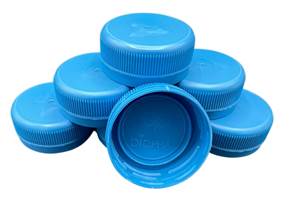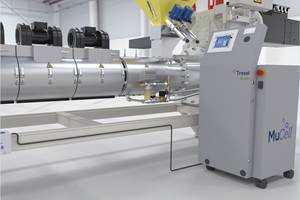Recyclers Find New Ways to Get More Out of Waste
Enhancing properties of recycled resins, especially commingled mixtures, was one theme of the recent Fifth Annual Recycling Conference, held by the SPE Recycling Div. in Chicago. Using new chemical compatibilizers and other new additives was one approach presented at the meeting. Another was a mechanical processing method that's said to achieve comparable results without additives. Other new developments at the meeting included improved resin-identification instruments, and a new type of silo that can discharge hard-to-move flake or fiber scrap.
Additives can help
With a little help in boosting mechanical properties, recycled polyolefins or engineering resins can be made suitable for reuse in their original applications. A new means to that end is Recycloblend additive from Ciba Specialty Chemicals, Tarrytown, N.Y. Recycloblend is a combination of an antioxidant, co-stabilizers, and other reactive and non-reactive additives that are said to help restore virgin-like material properties. Depending on the purity of the recycled material, about 0.5-1% of the additive is needed. It is offered in a dust-free pellet.
A Dutch firm has developed a new chemical compatibilizer that bonds with recycled plastics that contain different polymers. Developed by Bennet Europe BV in Almere, Netherlands, the new additive is added during batch blending to upgrade mechanical properties. It can be used to enhance the performance of virgin materials too, says Ben van der Groep, technical director. The Bennet additive can be used with both amorphous and crystalline materials, polar and nonpolar resins, and with rubbers. It also acts as a processing aid to improve melt flow and shorten cycle time.
Mechanical compatibilizer
Progress in recycling post-industrial mixes of polyethylenes with PVC and PET without the expense of compatibilizers or other additives was reported by researchers from the Polymer Technology Center at Northwestern University's Dept. of Chemical Engineering in Evanston, Ill. Headed by Dr. Klementina Khait, research associate professor and director of the Center, the group has produced uniform, melt-processable blends with ultimate tensile strength and flexural modulus comparable to virgin HDPE and LLDPE, which constituted the majority of the blends. Four of the five blends tested contained 5% PVC by weight, and two had 15 and 20% PET. Elongation of the blends averaged about 40% of that for virgin HDPE, while Izod impact was about 50% that of virgin PP. Khait says these blends can be used in applications requiring ultimate tensile strength typical of common polyolefins, but where some loss in impact and elongation is acceptable. However, a blend of LLDPE with 30% PET has higher tensile and flexural properties, plus impact strength 50% higher than typical PP, Khait notes.
These results are the latest achievements of a recycling process the Center has been developing for several years. Called Solid State Shear Pulverization (S3P), it uses a specially built twin-screw compounder from Berstorff Corp., Florence, Ky. The S3P process shears the resins on a molecular level without heating or melting, creating "self-compatibilized" blends. The recombined material is pulverized, creating a pastel-colored powder.
Khait says the S3P process also shows promise in reprocessing a mix of FR-ABS and HIPS with different viscosities. S3P created a powder that was injection molded into bars that did not delaminate during tests of mechanical strength. Mechanical properties mimicked those of ABS in all cases except impact.
Resin ID gets handier
Infrared Fiber Systems (IFS) Inc., Silver Spring, Md., unveiled its first portable device for identifying the type of plastic, foamed or solid, in a pellet or part. The new PlastiScan HH (hand-held) system comprises a computer, LCD display, and near-infrared (NIR) measuring instrument that analyzes the chemical composition of the sample within 0.5 sec. The sample must be in contact with the device, and it cannot "read" black or dark-colored parts. It comes with a database of NIR "signatures" of 10 plastics, and 10 more are optional. It runs on a battery pack or can be plugged into a wall socket. Price is $13,500.
SpectraCode of West Lafayette, Ind., says its RP-1 point-and-shoot resin-identification system now has improved recognition software and adjustable laser power so that it does not burn the sample, says CEO Edward Grant. The unit uses Raman infrared spectroscopy via a hand-held "gun" to identify all major polymers, including many black and deeply pigmented compositions. It even identifies dirty samples or ones with surface irregularities, says Grant. The hand-held laser gun is attached to an umbilical cord, which is connected to a Pentium-based computer with image-processing software and display console. Two RP-1 units are being used at the Vehicle Recycling Development Center at Visteon, a div. of Ford Motor Co., says Grant.
SpectraCode also is developing a portable, 35-lb identification unit that uses another Raman technology and can differentiate PS from ABS. The prototype unit has an expandable resin database that can accommodate 25-30 material families.
Move a mess of flake
Ground flake is typically hard to convey in bulk and usually must be handled in smaller quantities. But now there's a silo that makes it easy to unload chopped film, fibers, PET bottle flake, and other hard-to-convey materials. This silo from Laidig Industrial Systems, Mishawaka, Ind., has a discharge cone at the bottom with a 45° or 60° angle. A discharge auger sweeps 360° around the cone while it turns. Screw rotation and travel speed are separately adjustable.
Related Content
PHA Compound Molded into “World’s First” Biodegradable Bottle Closures
Beyond Plastic and partners have created a certified biodegradable PHA compound that can be injection molded into 38-mm closures in a sub 6-second cycle from a multicavity hot runner tool.
Read MoreHow to Optimize Color Evaluation of Recycled Plastics
The right color measurement instrument and good working methods will minimize variability in color evaluation of PCR.
Read MoreMultilayer Solutions to Challenges in Blow Molding with PCR
For extrusion blow molders, challenges of price and availability of postconsumer recycled resins can be addressed with a variety of multilayer technologies, which also offer solutions to issues with color, processability, mechanical properties and chemical migration in PCR materials.
Read MoreFoam-Core Multilayer Blow Molding: How It’s Done
Learn here how to take advantage of new lightweighting and recycle utilization opportunities in consumer packaging, thanks to a collaboration of leaders in microcellular foaming and multilayer head design.
Read MoreRead Next
For PLASTICS' CEO Seaholm, NPE to Shine Light on Sustainability Successes
With advocacy, communication and sustainability as three main pillars, Seaholm leads a trade association to NPE that ‘is more active today than we have ever been.’
Read MoreBeyond Prototypes: 8 Ways the Plastics Industry Is Using 3D Printing
Plastics processors are finding applications for 3D printing around the plant and across the supply chain. Here are 8 examples to look for at NPE2024.
Read MoreLead the Conversation, Change the Conversation
Coverage of single-use plastics can be both misleading and demoralizing. Here are 10 tips for changing the perception of the plastics industry at your company and in your community.
Read More













